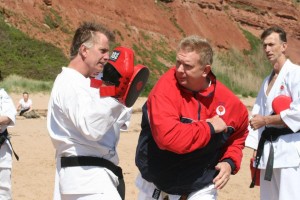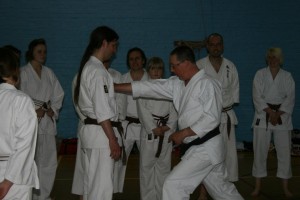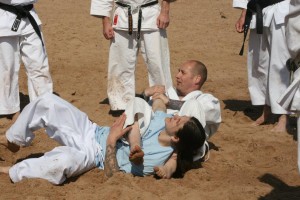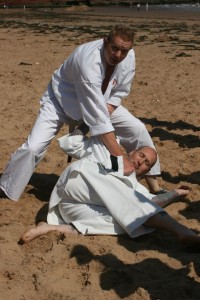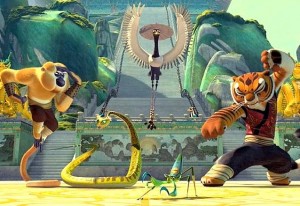“The ultimate aim of Karate lies not in victory or defeat, but in the perfection of character of its participants”.
Master Gichin Funakoshi.
 The above words by Master Funakoshi, founder of Shotokan/Shotokai have been widely quoted, but I wonder if that was what his teachers had in mind. Gichin Funakoshi had a number of teachers, but the main ones were Yasutsune Itosu and Yasutsune Azato. Both of these had (prior to teaching Funakoshi) been body guards to the King of Okinawa. In this role, they could have been faced with superior numbers of armed men, whilst they themselves were actually unarmed due to Japanese law.
The above words by Master Funakoshi, founder of Shotokan/Shotokai have been widely quoted, but I wonder if that was what his teachers had in mind. Gichin Funakoshi had a number of teachers, but the main ones were Yasutsune Itosu and Yasutsune Azato. Both of these had (prior to teaching Funakoshi) been body guards to the King of Okinawa. In this role, they could have been faced with superior numbers of armed men, whilst they themselves were actually unarmed due to Japanese law.
If you had to face a superior number of men, they had weapons whilst you did not; which do you think you would be most interested in:
- Victory or defeat?
- Perfection of character?
I don’t doubt that self development/perfection of character has always been part of the training, but I do doubt that it would have been the main focus when your very life could be on the line. However, it helps to have a look at what was happening in Japanese society when Funakoshi went to Japan and what Funakoshi’s own goals would have been.
Funakoshi travelled to and demonstrated Karate in Tokyo, Japan in 1922. At that time Japan was modernising very fast. Japan had been almost completely isolationist under the Tokugawa Shogun until being forcibly opened up by the American fleet in 1853. This humiliation led to the overthrow of the Shogun and the reinstatement of the Emperor in 1868 (Meiji Restoration). From this point on, Japan under the Emperor eagerly and hungrily absorbed whatever it could from the West, not least of all in terms of weapon and armaments.
Having found that raw recruits with a few hours training could easily shoot and kill a charging Samurai with several decades of training, it is understandable that traditional martial arts were being seen as obsolete from the a real combat point of view. The rival clans and warlords had lost their power which had shifted from clan Samurai to the new Japanese military forces answerable only to the Emperor and Japanese government. Japan was moving ahead more and more as a single formidable unit and developing it Imperial ambitions overseas.
From August 1894 to April 1895 Japan had fought China for control of Korea and had won.
From February 1905 to Sept 1905, Japan fought Russia over Korea and Manchuria and again came of best.
Parallel to this, it is interesting to note that after the death of the King of Okinawa (exiled in Tokyo since the Emperor regained control of Japan), Yasutsune Itosu started to teach Karate publicly in Okinawan schools in 1905. He was then 71 and this was the first time that he’d taught publicly. By 1905 Okinawa had been much more integrated into being part of Japan rather than just an occupied territory. An ambitious Japan had military conscription and it had been noted that youths with Karate training had better physiques and took to military training better than those without Karate training.
So what were Itosu’s motives behind this sudden change in policy and teaching this previously secret art to the public for the first time? It is hypothesised by Bruce Clayton PhD in his brilliant book, Shotokan’s Secret, that the bodyguards would have had some kind of oath of secrecy to the King of Okinawa. When the king died in exile, the oath was no longer binding so Itosu was free to teach publicly.

As Karate trained youths performed better when conscripted, arguably this sudden expansion of Karate training was to prepare young men for war. This may sound horrifying to us today, but that was a different society with different values and unquestioning loyalty to the Emperor was an important social value.
So bearing in mind that traditional martial arts were seen as obsolete from a combat perspective, and that you don’t really want school children damaging themselves too much in a playground brawl, what do you suppose was the emphasis of the teaching? Most likely the emphasis would have been to toughen up young men physically and mentally. Not for self defence in the usual (Western) sense of the words, but so that they could be physically and mentally tough when fighting with bullets, bombs and bayonets. Being mentally tougher to serve the Emperor without question (and without mercy to the enemy) would have been “perfection of character” under those societal conditions.
But before we condemn, the British Empire (and other colonial powers in their day) committed many atrocities to build their empires. We also taught our you men at school similar “values” to protect “king and country”. This was considered normal and patriotic at that time.
Later in 1922 when Funakoshi travelled to Tokyo, many Japanese martial arts had already transformed from their combat form (Jutsu) to self development form (Do). Judo had been created from Ju Jutsu, Aikido had been created from Aiki Jutsu and so on. Furthermore the Japanese tended to look down on the Okinawans who they saw as a bit primitive and backward, so for Funakoshi to gain acceptance of his Okinawan art, he had to go with the flow of Japanese martial arts and emphasis the “Do” as well.
Funakoshi’s main sponsor in Japan was Jigoro Kano, creator of Judo. Kano also worked for the Ministry of Education and represented Japan as the first Asian member of the International Olympics Committee (IOC), so he was a very influential ally to have. As Kano had changed his combat Ju Jutsu into a sport and a Do, Funakoshi would have been obliged to do similar things with Karate.
That said, I do believe that Funakoshi took the self development side very seriously and was very genuine in his beliefs. Unlike his teachers, he had never been a bodyguard, facing superior numbers of armed men. Furthermore, there are hardly any records of Funakoshi getting involved in any real fights. This goes back to his early years too, when he would have likely learnt the combat emphasis of the art. In later years in Japan, Funakoshi was challenged many times by Japanese Judo and Ju Jutsu exponents, keen to show that their art was superior to this strange new art from backward Okinawa being introduced by this diminutive Master. But Funakoshi consistently refused all challenges as he believed that it would be dishonourable to himself and his art. It is unlikely that Funakoshi declined out of fear. Funakoshi’s master, Itosu, at the age of 75 had been challenged by a Judo expert who thought that Judo should be taught in Okinawan schools rather than Karate. Having dispatched his opponent (who was about half his age) with just one punch, Itosu applied first aid and left.
Funakoshi would have probably been able to do the same and gain respect and credibility for the effectiveness of Karate at the same time. It could have been a good way to speed up Japanese acceptance and gain more students, but Funakoshi was adamant that he would not lower himself. So this (and many other stories) would indicate that Funakoshi was indeed a man of great integrity and honour. He did not just say that Karate was about self development, he lived according to what he taught.
In his autobiography he recalls how just after the Second World War ended Japan was in chaos and people were starving. On his way home, he was accosted a by a younger man who tried to rob him. Funakoshi was in his senior years and very short. As the young man swung at him, Funakoshi easily evaded, then grabbed and squeezed the other mans testicles. Most of us would say fair enough the young man deserved it. But as Funakoshi reflected he realised that the young man probably had a family to support and acted out of character in shear desperation. He was overcome by a terrible feeling of guilt and shame that he would have caused this man excruciating agony when he was already in such desperate circumstances. Not many of us would have been so generous to a man who had just tried to mug us. Most of would have proudly recalled the story of how we gave some young thug what he deserved. Funakoshi was truly a man of great character and honour, no doubt his Karate training had a great deal to do with this.

